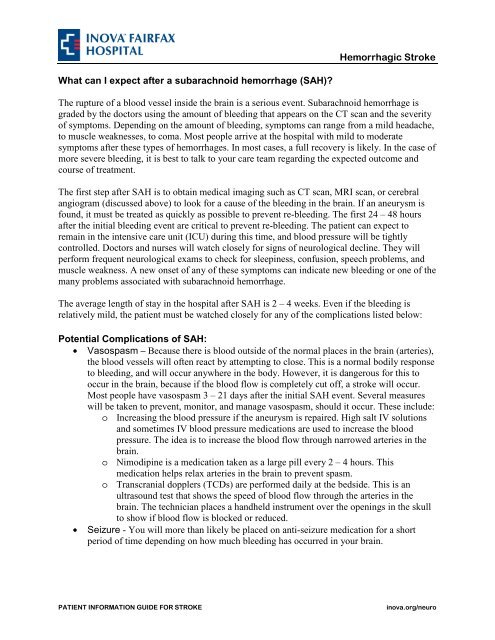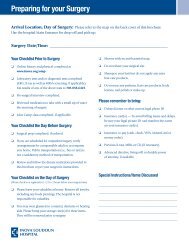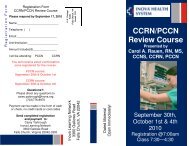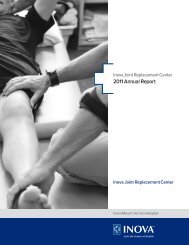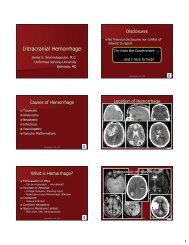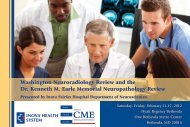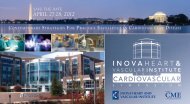Fairfax Hospital Neuroscience Services - Inova Health System
Fairfax Hospital Neuroscience Services - Inova Health System
Fairfax Hospital Neuroscience Services - Inova Health System
You also want an ePaper? Increase the reach of your titles
YUMPU automatically turns print PDFs into web optimized ePapers that Google loves.
Hemorrhagic Stroke<br />
What can I expect after a subarachnoid hemorrhage (SAH)?<br />
The rupture of a blood vessel inside the brain is a serious event. Subarachnoid hemorrhage is<br />
graded by the doctors using the amount of bleeding that appears on the CT scan and the severity<br />
of symptoms. Depending on the amount of bleeding, symptoms can range from a mild headache,<br />
to muscle weaknesses, to coma. Most people arrive at the hospital with mild to moderate<br />
symptoms after these types of hemorrhages. In most cases, a full recovery is likely. In the case of<br />
more severe bleeding, it is best to talk to your care team regarding the expected outcome and<br />
course of treatment.<br />
The first step after SAH is to obtain medical imaging such as CT scan, MRI scan, or cerebral<br />
angiogram (discussed above) to look for a cause of the bleeding in the brain. If an aneurysm is<br />
found, it must be treated as quickly as possible to prevent re-bleeding. The first 24 – 48 hours<br />
after the initial bleeding event are critical to prevent re-bleeding. The patient can expect to<br />
remain in the intensive care unit (ICU) during this time, and blood pressure will be tightly<br />
controlled. Doctors and nurses will watch closely for signs of neurological decline. They will<br />
perform frequent neurological exams to check for sleepiness, confusion, speech problems, and<br />
muscle weakness. A new onset of any of these symptoms can indicate new bleeding or one of the<br />
many problems associated with subarachnoid hemorrhage.<br />
The average length of stay in the hospital after SAH is 2 – 4 weeks. Even if the bleeding is<br />
relatively mild, the patient must be watched closely for any of the complications listed below:<br />
Potential Complications of SAH:<br />
• Vasospasm – Because there is blood outside of the normal places in the brain (arteries),<br />
the blood vessels will often react by attempting to close. This is a normal bodily response<br />
to bleeding, and will occur anywhere in the body. However, it is dangerous for this to<br />
occur in the brain, because if the blood flow is completely cut off, a stroke will occur.<br />
Most people have vasospasm 3 – 21 days after the initial SAH event. Several measures<br />
will be taken to prevent, monitor, and manage vasospasm, should it occur. These include:<br />
o Increasing the blood pressure if the aneurysm is repaired. High salt IV solutions<br />
and sometimes IV blood pressure medications are used to increase the blood<br />
pressure. The idea is to increase the blood flow through narrowed arteries in the<br />
brain.<br />
o Nimodipine is a medication taken as a large pill every 2 – 4 hours. This<br />
medication helps relax arteries in the brain to prevent spasm.<br />
o Transcranial dopplers (TCDs) are performed daily at the bedside. This is an<br />
ultrasound test that shows the speed of blood flow through the arteries in the<br />
brain. The technician places a handheld instrument over the openings in the skull<br />
to show if blood flow is blocked or reduced.<br />
• Seizure - You will more than likely be placed on anti-seizure medication for a short<br />
period of time depending on how much bleeding has occurred in your brain.<br />
PATIENT INFORMATION GUIDE FOR STROKE<br />
inova.org/neuro


